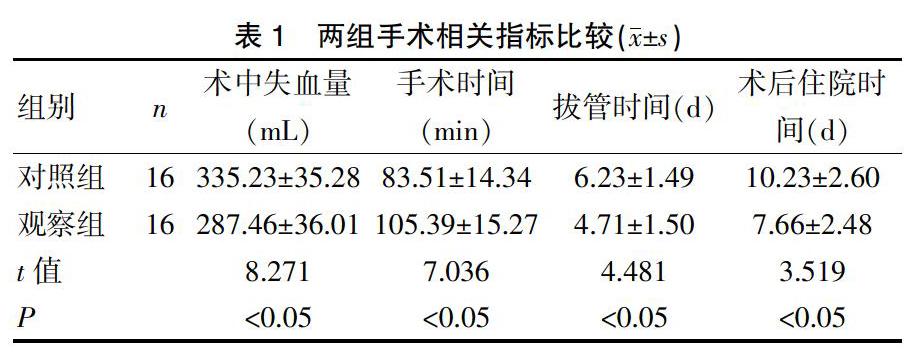腹腔镜脾脏切除术16例临床分析
2020-10-13龚海军余春华鲁钢
龚海军 余春华 鲁钢



[摘要] 目的 以肝硬化致脾功能亢進患者为研究对象,探讨患者应用腹腔镜脾脏切除术的治疗效果。 方法 将2018年1月~2019年12月接受手术治疗肝硬化致脾功能亢进症患者32例随机分成两组,对照组16例患者应用开腹脾脏切除术治疗,观察组16例患者应用腹腔镜脾脏切除术治疗,观察对比两组手术相关指标、手术前后肝功能指标及术后并发症情况。 结果 观察组术中失血量(287.46±36.01)mL、手术时间(105.39±15.27)min、拔管时间(4.71±1.50)d、术后住院时间(7.66±2.48)d,对照组各项指标分别为(335.23±35.28)mL、(83.51±14.34)min、(6.23±1.49)d、(10.23±2.60)d,观察组术中失血量少于对照组,手术时间长于对照组,拔管时间以及术后住院时间均短于对照组(P<0.05)。术后观察组DBIL为(7.23±1.30)μmol/L、AST为(37.28±4.39)μmol/L、ALT为(40.13±3.28)μmol/L,对照组各项指标分别为(9.64±1.35)μmol/L、(51.19±4.47)μmol/L、(47.36±3.31)μmol/L,差异有统计学意义(P<0.05)。观察组TBIL为(26.02±3.17)μmol/L、对照组为(25.68±3.19)μmol/L,两组TBIL水平无统计学意义(P>0.05)。观察组无肺部感染者,胸腔积液率为6.25%、切口感染率为6.25%、腹腔积液率为12.50%。观察组肺部感染、胸腔积液及切口感染发生率均较对照组低(P<0.05),两组腹腔积液发生率差异无统计学意义(P>0.05)。 结论 腹腔镜脾脏切除术在肝硬化致脾功能亢进治疗中的应用价值较高,能够取得确切疗效且治疗安全性较高,可显著改善患者肝功能。
[关键词] 腹腔镜脾脏切除术;肝硬化;脾功能亢进;肝功能;手术指标;术后并发症
[中图分类号] R657.6 [文献标识码] B [文章编号] 1673-9701(2020)24-0046-03
[Abstract] Objective To explore the therapeutic effect of laparoscopic splenectomy(LS) on the patients with hypersplenism caused by hepatocirrhosis. Methods 32 patients with hypersplenism caused by hepatocirrhosis who received surgical treatment from January 2018 to December 2019 were randomly divided into two groups. The 16 patients of the control group were treated with open splenectomy, while the 16 patients of the observation group were treated with LS. The operation-related indexes, liver function indexes before and after operation and postoperative complications of the two groups were observed and compared. Results In the observation group, the intraoperative blood loss was(287.46±36.01) mL, the operation time was(105.39±15.27) min., the extubation time was(4.71±1.50) d, the postoperative hospitalization time was(7.66±2.48) d, while in the control group, the corresponding indexes were(335.23±35.28) mL, (83.51±14.34) min, (6.23±1.49) d, and(10.23±2.60) d respectively. The blood loss in the observation group was less than that in the control group, the operation time was longer than that in the control group, and the extubation time and the postoperative hospitalization time were both shorter than those in the control group(P<0.05). The DBIL of the observation group after operation was(7.23±1.30) μmol/L, the AST was(37.28±4.39) μmol/L, and the ALT was(40.13±3.28) μmol/L, while these indexes of the control group were(9.64±1.35) μmol/L, (51.19±4.47) μmol/L, and(47.36±3.31) μmol/L respectively, the difference was statistically significant(P<0.05). The TBIL of the observation group was(26.02±3.17) μmol/L, while that of the control group was(25.68±3.19) μmol/L, with no statistically significant difference in TBIL level between the two groups(P>0.05). There was no pulmonary infection in the patients of the observation group, the incidence of pleural effusion was 6.25%, the incidence of incision infection was 6.25%, and the incidence of peritoneal effusion was 12.50%. The incidence of pulmonary infection, pleural effusion and incision infection in the observation group was lower than that in the control group(P<0.05), and there was no statistically significant difference in the incidence of peritoneal effusion between the two groups(P>0.05). Conclusion LS has great application value in the treatment of hypersplenism caused by hepatocirrhosis. It produces definite therapeutic effect and has sound safety in treatment, which can significantly improve the patients liver functions.
综上所述,肝硬化患者肝功能储备较差,开腹手术及腹腔镜脾脏切除术均有助于促进其肝功能改善,但是与开腹手术相比,腹腔镜脾脏切除术在肝硬化致脾功能亢进治疗中疗效更加确切,创伤小、术后并发症少、恢复快,值得临床应用。
[参考文献]
[1] 李毅. 腹腔镜下脾门血管精细解剖+超声刀钳夹法在脾部分切除术中的应用[J]. 腹腔镜外科杂志,2019,24(4):263-266.
[2] 彭俊. 腹腔镜下门静脉高压症巨脾切除术中优先离断脾蒂的效果观察[J]. 广西医学,2019,41(2):260-262.
[3] 张明,黄君. 腹腔镜脾脏切除术治疗肝硬化脾功能亢进症患者的疗效观察[J]. 中国医疗器械信息,2018,24(14):9-10.
[4] 王璐,宋博. 保留脾脏的腹腔镜胰腺远端切除术在治疗胰体尾部占位性病变中的可行性[J]. 临床医学研究与实践,2019,4(20):48-50.
[5] 汪祖来,黄顺荣. 腹腔镜脾脏切除术的手术方式及应用进展[J]. 中国临床新医学,2019,12(2):237-240.
[6] 孫成文. 36例腹腔镜脾脏切除术效果观察[J]. 河南外科学杂志,2018,24(1):112-113.
[7] 刘清华,汪凌,蹇泽英,等. 腹腔镜脾脏切除联合贲门周围血管离断术与开腹手术疗效比较[J]. 临床医药文献电子杂志,2019,6(9):32.
[8] 覃勇辉,徐邦浩,王继龙,等. 腹腔镜下保留脾脏的全胰腺切除术1例报告并文献复习[J]. 腹腔镜外科杂志,2019,24(10):770-773.
[9] 王树鹏,管清春,王守乾,等. 腹腔镜脾部分切除术治疗脾脏占位性病变的临床效果及预后观察[J]. 中国现代医学杂志,2019,29(15):120-122.
[10] 于阜杰,吴瑶,余晶. 腹腔镜下脾切除术与开腹脾切除术的疗效对比及应用体会[J]. 当代医学,2019,25(31):126-127.
[11] 严辉弟,周立新,王茂林,等. 腹腔镜与开腹保留脾脏的胰腺远端切除术的临床对比研究[J]. 腹腔镜外科杂志,2019,24(2):103-106.
[12] 朱楷,曾勇,喻昆霖,等. 二级脾蒂离断法腹腔镜脾切除术的临床应用[J]. 当代医学,2019,25(30):177-178.
[13] 李航. 腹腔镜脾切除术的临床应用进展[J]. 河北医科大学学报,2020,41(3):354-358.
[14] 郑磊,李芳芳. 腹腔镜脾切除术在创伤性脾破裂中的应用[J]. 现代医药卫生,2019,35(8):1220-1222.
[15] 马双阳,戴兵,刘驰,等. 腹腔镜与开腹脾切除贲门周围血管离断术治疗门静脉高压症的临床疗效分析[J]. 临床外科杂志,2019,27(7):592-594.
(收稿日期:2020-05-15)
